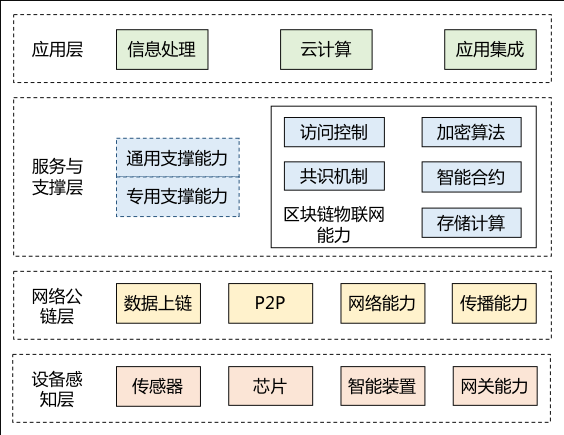The Internet of Things (IoT), as an important field of the new generation of information technology, has its value and significance widely recognized by society. IoT devices are interconnected through networks, generating massive amounts of data and integrating powerful data analysis capabilities, which are expected to fundamentally change human production and lifestyle. However, while providing development opportunities, the current IoT industry still faces many issues in scalability, compatibility, and security, severely limiting the space for the integration and development of IoT with various industries and hindering the realization of its potential value. Blockchain, as an emerging technology, can effectively address the data management, trust, security, and privacy issues faced in the development of IoT.
Urgent Need for Innovation in Blockchain and IoT Integration
The Internet of Things (IoT) is recognized as an important field of the new generation of information technology, with its value and significance widely acknowledged by society. Industrial equipment, automobiles, household appliances, and other items are interconnected through networks, generating vast amounts of data combined with powerful data analysis capabilities, promising to change production and lifestyle while generating enormous social and commercial value. However, while providing development opportunities, the current IoT industry still faces many challenges. Firstly, the IoT has a lengthy industrial chain involving numerous technical fields, resulting in a slow value transmission effect in the market channels; secondly, the trust and value systems among devices, various users, and service platforms in IoT systems are still unclear, making it difficult for IoT to integrate into other industries; furthermore, centralized IoT platforms constructed by manufacturers or service providers often have the authority to collect and analyze user data and control user devices without user consent, posing significant risks to device security and user privacy. These three aspects limit the space for the integration and development of IoT with various industries and hinder the realization of its potential value.
Blockchain integrates technologies such as distributed data storage, peer-to-peer transmission, consensus mechanisms, and cryptographic algorithms, featuring five technical characteristics: decentralization, trustlessness, tamper-resistance, traceability, and anonymity. The integration of blockchain with IoT can effectively address the data management, trust, security, and privacy issues faced in IoT development, helping scalable devices build efficient, trustworthy, and secure distributed IoT networks, deploying massive data-intensive applications, and providing effective protection for user privacy. The inclusion of blockchain technology can also improve operational efficiency and industrial asset utilization, thereby enhancing the value of IoT systems. Additionally, leveraging the vast application space provided by IoT is expected to develop more mature blockchain applications, contributing to the expansion of the blockchain industry scale and promoting the improvement of the industrial ecosystem.
Theoretical Blockchain Technology for IoT Applications
Blockchain is a peer-to-peer distributed ledger technology based on cryptographic algorithms, essentially a shared distributed database. Blockchain technically addresses the security issues arising from the trust-based centralized model for the first time, ensuring the secure transfer of data and value based on cryptographic algorithms, guaranteeing the traceability and tamper-resistant characteristics of data through hash chains and timestamp mechanisms, and ensuring the consistency of block data among nodes through consensus algorithms.
Blockchain technology is not a brand new technology but an innovative collection of existing technologies, including P2P network technology, hash algorithms, Merkle trees, proof-of-work mechanisms, and asymmetric encryption technologies. Blockchain is a data structure where blocks containing transaction information are linked in order from back to front. Each block header contains the hash value of its parent block, thus creating a chain that can be traced back to the first block (the genesis block) through the hash value sequence linking each block to its parent block. As new blocks are produced on the chain, the local copies of the blockchain are continuously updated to maintain this chain, ensuring the final consistency of each blockchain copy through consensus algorithms and other synchronization mechanisms. The blockchain network is a distributed peer-to-peer network where each full node stores all transaction data without the need for a third party or centralized node to control transactions or data. This distributed data management architecture endows blockchain applications with technical characteristics such as decentralization, openness, autonomy, tamper-resistance, and anonymity. Among them, the “decentralization” characteristic is a natural result of distributed computing, where data is collectively shared and maintained in a distributed manner. Participants in the system can directly access information based on their needs within the scope of their permissions without needing an intermediary platform. “Autonomy” means that all blockchain nodes build relationships by following a unified consensus algorithm rather than being based on trust-based connections. The “tamper-resistance” characteristic aims to ensure the stability and reliability of data, reducing the risk of data tampering. “Openness” means that, apart from protecting the private information of the transaction parties, anyone can query blockchain data through open interfaces or develop related decentralized applications. “Anonymity” refers to the use of asymmetric encryption, hash algorithms, and other cryptographic technologies to help achieve user privacy protection. These technical characteristics help blockchain provide reliable, theoretically supported solutions to the data management, trust, security, and privacy issues faced in IoT.
System Architecture for Blockchain and IoT Integration
The inherently distributed and trusted characteristics of blockchain provide new ideas for designing the framework and system architecture for the integration of blockchain and IoT. In intelligent IoT computing, multiple IoT devices running intelligent algorithms are dispersed in edge networks. To collaboratively complete artificial intelligence computing tasks or jointly conduct intelligent group decisions, these devices need to communicate frequently. However, both the devices themselves and the communication between devices face various network security threats, such as the possibility of device malfunctions or malicious attacks, where the information transmitted may be leaked or altered. Blockchain, as a cryptographically supported, verifiable, and tamper-resistant ledger, can ensure secure interactions in a decentralized and untrusted environment through transaction records and distributed consensus on the validity of transaction records, playing a role in intelligent IoT computing scenarios. At the same time, the consensus mechanism and incentive mechanism of blockchain, combined with smart contracts, are naturally suitable for constructing an economic market, effectively incentivizing the sharing and interaction of information in IoT computing.
According to relevant institutions’ forecasts, the number of IoT devices globally is expected to reach hundreds of billions by 2020. With the rapid increase in the number of devices in IoT, service demands continue to rise, and the costs of constructing and maintaining data center infrastructure have significantly increased, along with growing security risks and performance bottlenecks in related IoT business platforms. Designing new IoT service models has become a strategic focus for innovation among various enterprises and institutions, and integrating blockchain technology to build a “decentralized” IoT system architecture has become one of the important models.
Figure 1: Blockchain IoT Integration Architecture
The IoT architecture built by integrating blockchain technology is a “decentralized” business architecture (as shown in Figure 1). The blockchain IoT platform can be divided into a device perception layer, a network public chain layer, a service and support layer, and a user-facing application layer. The device perception layer interfaces with physical objects, supporting the collaboration of IoT entities (e.g., IoT devices, IoT servers, IoT gateways, service gateways, and end-user devices) in a “decentralized” mode and can collect information through sensors. The collected information and data are stored on the public chain for traceability and tamper-resistance, transmitting information through peer-to-peer distributed connections. Most of the new capabilities required by the integrated architecture focus on the service and application support layer, including access control, consensus mechanisms, cryptographic support, contract management, storage, and computation. Meanwhile, the application layer, facing customers, requires IoT applications, IoT devices, and IoT gateways to communicate and collaborate through the capabilities provided by the service and application support layer to further process information and provide intelligent services.
Disclaimer:The public chain alliance, as an open information sharing platform, provides all information solely representing the author’s personal views, which do not reflect the platform’s stance and do not constitute any investment or financial advice..

